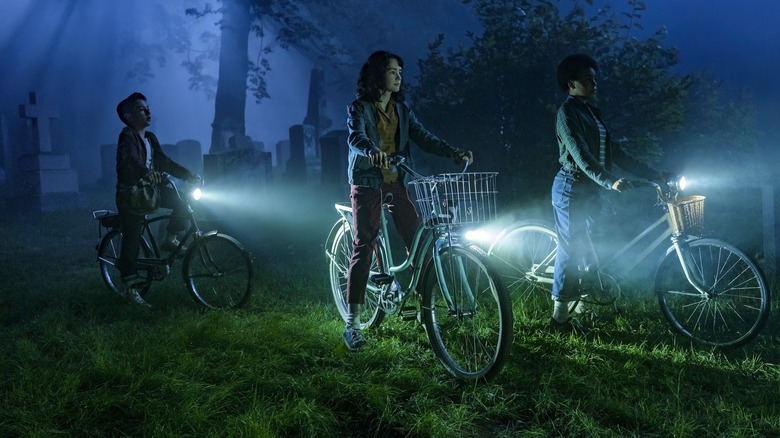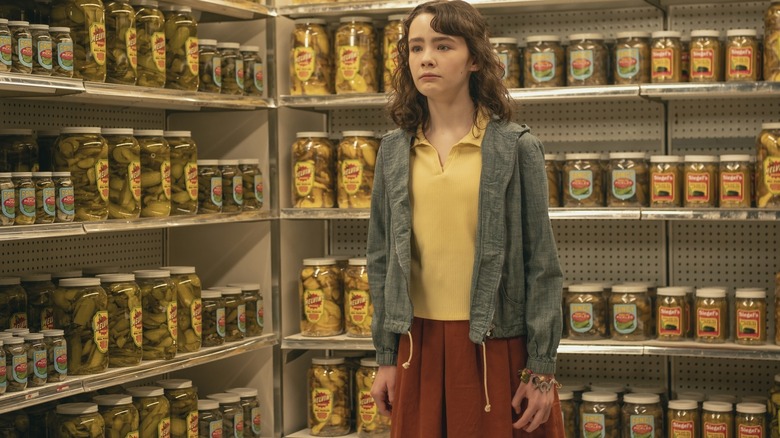It: Welcome To Derry Repeats One Major Mistake From The Movies
Warning: Don't look into the Deadlights. This article contains spoilers for episode 3 of "It: Welcome to Derry."
Through three episodes of "It: Welcome to Derry," the HBO show has somehow taken one of the more uninspired ideas out there (hey, what if we made a prequel to the "It" movies?) and made it better than it has any right to be. Contrary to popular belief, it actually helps that the writing team didn't have the benefit of any singular Stephen King text to drawn from. Instead, by taking inspiration from several King novels and aspects of the original "It" book that weren't included in the Andy Muschietti blockbusters, the series enjoys almost endless possibilities for where to take this story next.
That display of creative freedom has been a tremendous boon in the early going, but fans may have started to notice a recurring element carried over from both "It" movies continues to drag this prequel back down to earth. For all the box office success of the big-screen adaptations, perhaps the most common criticism directed towards them had to do with their overreliance on dodgy visual effects work during some of the biggest scares. "Chapter Two" may have been the bigger offender in this regard, frequently concluding many horror-focused set pieces with unconvincing digital recreations of Pennywise (Bill Skarsgård) in its many spooky forms.
"Welcome to Derry" has taken a page out of its predecessors' book, but to much less effective results. Both the premiere and second episode went back to this well several times over, leading to imagery like the mutant baby, the birthing monster, and that severed head in the pickle jar. But episode 3 might very well be the low point so far, repeating the one major mistake from the "It" movies.
Overuse of VFX keeps undercutting the best scares in It: Welcome to Derry
A nagging pattern has become a trend and now risks turning into a bad habit through the first three episodes of "It: Welcome to Derry." When the premiere hour began with one of the most horrific sequences in the entire franchise, it was easy to look past the somewhat iffy computer-generated work involved in bringing that flying demon baby to life. As much as we like to talk about the superiority of practical effects, it's fair to acknowledge that that wasn't such an obvious decision for a claustrophobic action scene set within the confines of a single car. There was slightly less of an excuse when it came to that episode-ending massacre in the movie theater, or that traumatizing nightmare experienced by Ronnie Grogan (Amanda Christine) that ends with a cartoonish monster trying to gobble her up. By the time episode 3 builds to that gnarly cemetery set piece, only to be undone by VFX renderings straight out of a "Ghostbusters" movie, it's become impossible to ignore.
While it's easy to lay all the blame at the feet of Andy Muschietti, who returns from his directing work on the movies in the role of developer on the show (along with Barbara Muschietti and Jason Fuchs), this feels like a failure of imagination from top to bottom. What makes this so frustrating is that the design and staging of each scare has been exceptional. That aforementioned cemetery scene, where our new Losers Club attempts to summon Pennywise, escalates with a sense of tension that rivals many a horror film. The atmosphere and lighting and mounting dread should've made this a clear highlight of the show ... until it's all undercut by Casper the Sludgy-looking Ghost & Friends.
It: Welcome to Derry needs to get back to the horror basics
This needn't be the nail in the coffin for "It: Welcome to Derry," however. The creative team has already proven adept at taking clever and imaginative spins on the property's typical depiction of action. Characters experience their biggest fears, Pennywise exploits those with hallucinations put together like a Rube Goldberg contraption from hell, and only some last-minute heroics save them from certain death. As much as this formula threatens to feel played out and overdone, the show's unequivocal high points indicate a way forward for the rest of the season.
Look no further than some of the best and most emotionally-engaging sequences in the series so far: the chilling and gruesomely dark lamp scene, that grocery store scare (until the disembodied pickle-corpse of Lilly's late father appears), and the vision experienced by Chris Chalk's Dick Hallorann while up on that helicopter. All three find unique ways to manifest Pennywise as a cosmic tormentor who knows exactly how to twist in the knife for our protagonists, all while deploying some of the most classic horror tropes that stand the test of time. The first uses our knowledge of history against us, the second preys on everyone's childhood fear of getting lost in a labyrinthine maze, and the third is actually a fantastic use of VFX and spectacle — culminating in that haunting (and familiar) visual of all of Pennywise's "floating" victims in the sewers.
The HBO series has shown that it can live up to and even exceed the heights of the "It" movies; now, it needs to do so on a consistent basis. By taking a more back-to-basics approach, we'll all float, too. New episodes of "It: Welcome to Derry" stream on HBO and HBO Max every Sunday.


